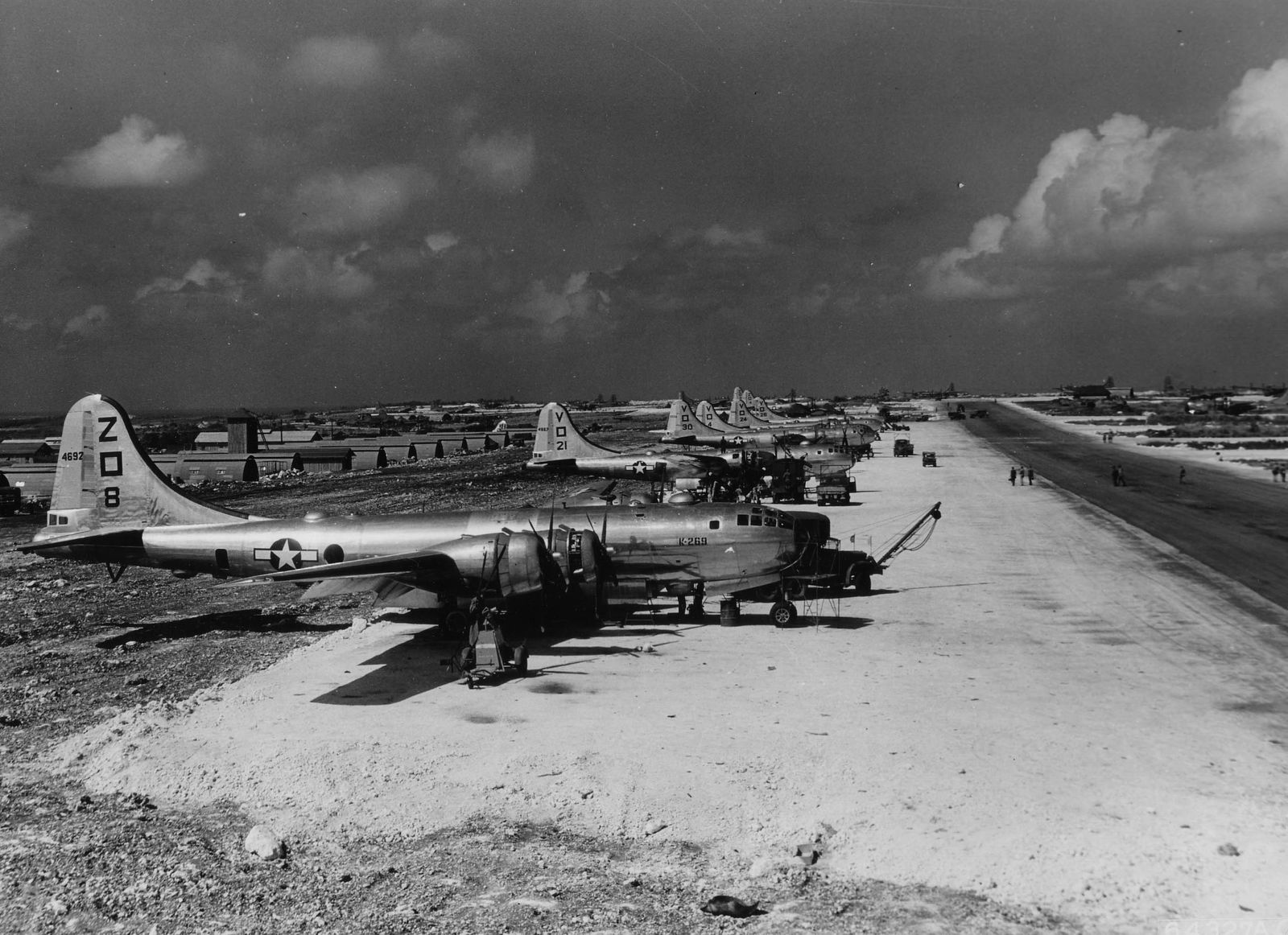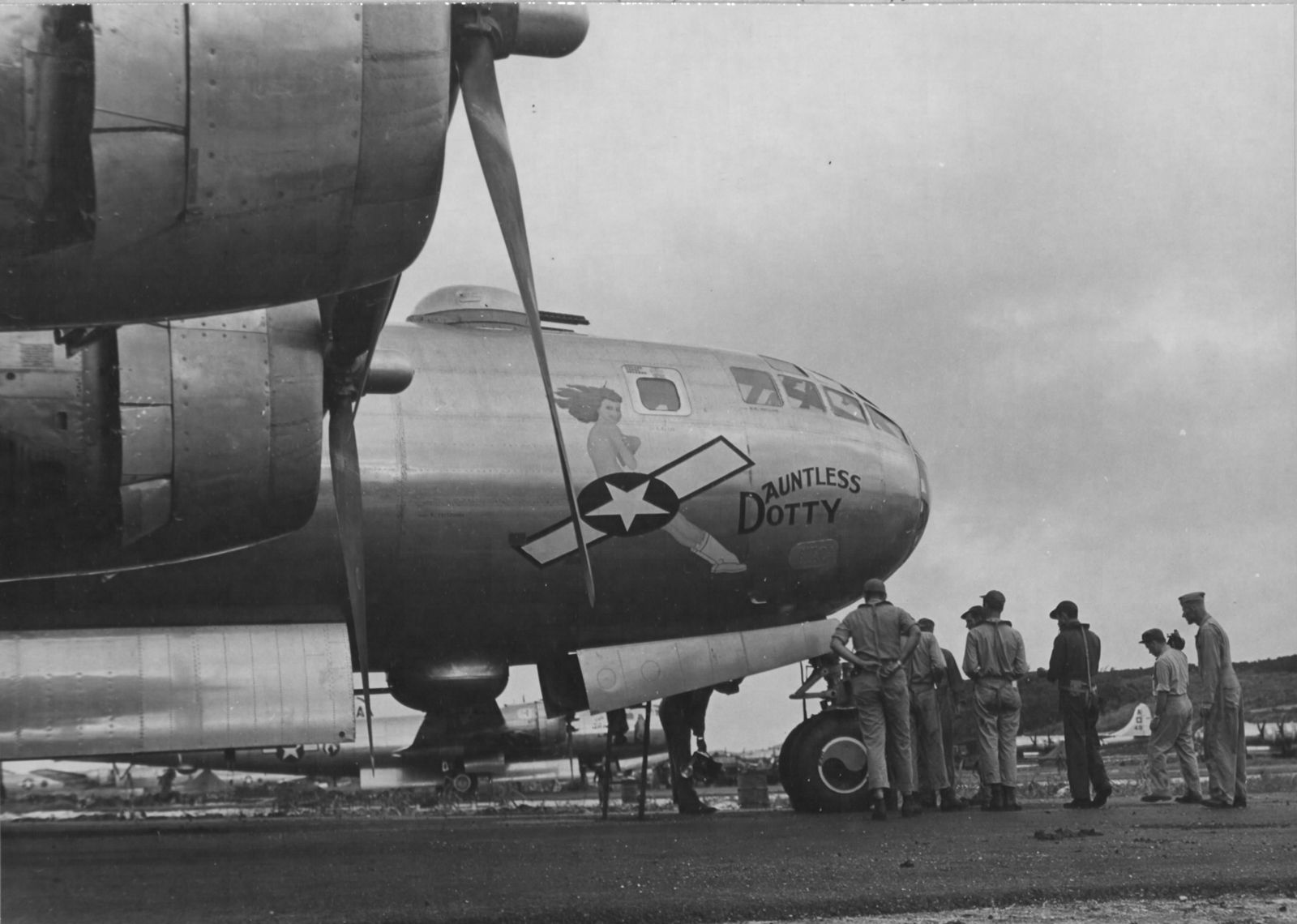
73rd Bomb Wing on Isley Field.

Dauntless Dotty
SINCE the beginning of the Pacific War, General Henry “Hap” Arnold, Commander, 20th Air Force, had dreamed of the day he would have enough B-29 Superfortresses on hand to bomb Japan into surrendering. However, production of the huge and technically complicated bomber was slow.
By mid-1943, sufficient B-29s had come off the assembly line and enough crews trained to organize the 58th Bombardment Wing. With no base close enough to Japan in American hands, in April 1944 the wing was sent to Kharagpur, India. From there, the big bombers could fly over the Himalayas to bases built in northern China, and from there to Japanese industrial targets in southern Japan, Korea, and Manchuria, an exceedingly inefficient operation.
Meanwhile, Admiral Ernest J. King, Commander, U.S. Fleet, pushed for the capture of the Mariana Islands. From there, the B-29s could fly directly to Japan. The Combined Chiefs of Staff eventually agreed, and June 15, 1944, became D-Day Saipan.
As the 2nd and 4th Marine Divisions prepared to land on Saipan’s southern beaches, B-29s from the 58th Bomb Wing hit the Japanese industrial city of Yawata on southern Kyoto. Although they did little real damage, they sent a clear message to the military leadership in Tokyo: “We will capture Saipan, Tinian, and Guam, and we will bomb Japan into submission.”
On July 9, Saipan was declared securely in American hands. General Hideki Tojo, Prime Minister and War Minister of Japan, was forced to resign on July 18. Knowing that more and more B-29s would be arriving in the Marianas, Japan could have surrendered and stopped the killing. They did not —choosing to sacrifice thousands of their civilian countrymen to aerial bombardment rather than accept the shame of defeat.
Virtually overnight, Seabees, Marine engineers and Army Air Force engineers, working two 10-hour shifts, seven days a week, transformed the Imperial Japanese naval air base at As Lito, southern Saipan, into a B-29 base the Navy named Isely Field.
On Oct. 12, 1944, the first B-29 Superfortress of the 497th Bomb Group, 73rd Bombardment Wing, arrived at Isley Field. The 498th, 499th and 500th Bomb Groups arrived shortly thereafter. The eleven men in the crew of each Superfortress were mostly kids. They were essentially a college-age football team that had either volunteered or been drafted — not into the NFL, but the AAF. The youngest were only 17 years old, if they could get permission from their parents. The “old man” on the team was perhaps 23 or 24, a college graduate who had become a pilot, co-pilot, bombardier, or navigator. Scared to death, each plane’s team did the job they had been trained to do and flew a Superfortresses from a training base in Kansas or Nebraska, to California, then navigated across the broad Pacific to Hawaii, and finally Saipan. They discovered a tropical island that had been destroyed, then reconstructed into a sprawling military complex.
On Nov. 18, 1944, General Arnold ordered the 73rd to fly mission San Antonio 1, a strike against Tokyo, the first since the Doolittle Raid in 1942. Unfortunately, the weather turned bad and the mission was delayed. The weather finally cleared on Nov. 23. The mission was set to go on Nov. 24. Isley Field was far from complete. Only one runway was functional. Regardless, Brig. Gen. Emmet “Rosie” O’Donnell, Commander, 73rd Bombardment Wing, put every plane capable of flying on the flight line.
Just at sunrise, 0615, on Thanksgiving Day, 1944 (Nov. 23 in the mainland), 79 years ago today, the B-29 Dauntless Dottie, with O’Donnell at the controls and Maj. Robert K. Morgan, erstwhile pilot of the famed B-17 Memphis Bell in the co-pilot’s seat, rolled down the runway at Saipan. Hundreds of Seabees, Marines, and engineers swarmed around the airport to watch the 73rd take off, to the cheers of all. Another 110 B-29s from the 73rd, 90 percent of the Superfortress on Saipan, followed behind.
When they returned that evening the crews experienced empty bunks in their barracks, for the first time: Two planes had been lost— 22 men; 22 teammates, gone. Feelings about the mission were bitter-sweet as the airmen munched on turkey and mashed potatoes, and dreamed of home. They had faced death, become combat-tested, and moved the war forward; one day, one mission, closer to its end, and a flight home.
The raid did little real damage to Tokyo, but the crews, both in the air and on the ground, had gained combat experience, their aircraft tested, and problems identified that could be rectified. Japanese morale plummeted, knowing that this would be only the first of many such raids. American morale, both in the states and the Marianas, skyrocketed. Hollywood created the movie “Target Tokyo” based on this mission and narrated by Ronald Reagan (available on YouTube). And Americans on the home front learned a bit more about Pacific geography.
Those airmen from the 73rd Wing who survived the war undoubtedly remembered Mission San Antonio 1 every Thanksgiving Day for the rest of their lives, just as we do today.
The writer is a resident of Marpo Heights, Tinian.











